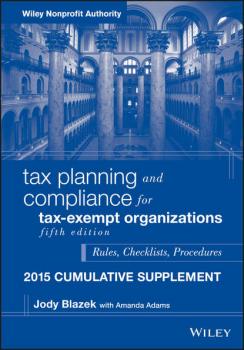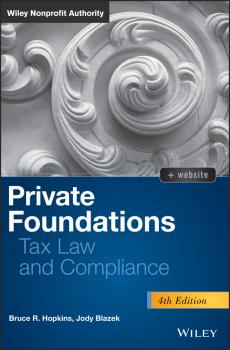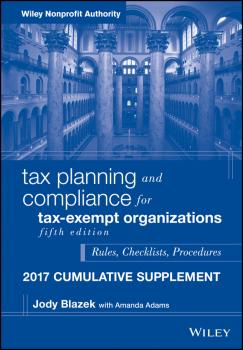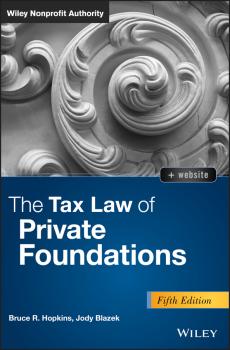ТОП просматриваемых книг сайта:















Jody Blazek
Список книг автора Jody BlazekАннотация
The essential nonprofit tax guide, updated with the latest rules and requirements The 2015 Cumulative Supplement to Tax Planning and Compliance for Tax-Exempt Organizations is the latest addition to the indispensable guide to navigating nonprofit tax issues stemming from evolving regulations and IRS procedures. This most recent supplement is packed with checklists and examples that ease the filing process. This new supplement is updated to align with the relevant changes in IRS forms, requirements, and procedures to help you ensure full compliance with the most up-to-date regulations. Clear, concise instructions guide you through important forms and documents, and expert discussion provides insight on specific issues such as unrelated business income, private inurement, affiliations, and employment taxes. Helpful checklists highlight critical concerns, sample documents provide clarification and example, and the nonprofit-specific guidance leads you through obtaining tax exemption, reporting, compliance testing, and lobbying expenditure management. Nonprofit organizations contend with the possibility of losing their tax-exempt status on a daily basis. Qualification, application, maintenance, and management—every aspect of that vital status requires a solidly executed strategy for ensuring compliance with federal, state, and local regulations. The 2015 Cumulative Supplement helps you put your strategy into action, with a host of valuable tools and expert guidance on the practical aspect of nonprofit tax planning. Follow line-by-line instructions for forms and applications Access easy checklists for reporting, compliance, eligibility, and more Examine sample bylaws, applications, and forms Utilize comparison charts and other visual aids for easy reference Review bullet lists that compare what is and what is not acceptable Tax rules and regulations change annually, and nonprofit organizations know that staying compliant means staying up to date. Wading through tax code is less than helpful in the field where clear, practically oriented instruction provides the quick reference accountants, lawyers, and executives need. The 2015 Cumulative Supplement to Tax Planning and Compliance for Tax-Exempt Organizations is the essential, time-saving guide to the latest in nonprofit tax rules, regulations, and procedures.
Аннотация
Stay updated on the latest tax regulations with this private foundation tax manual Knowledge of tax regulations surrounding private foundations isn't enough if you're an executive of such an organization or a professional supporting a tax-exempt foundation. Annual changes to IRS rules and increased scrutiny by regulators mean it's necessary for you to keep abreast of myriad changes that come into existence each year. From authors Bruce R. Hopkins and Jody Blazek comes the definitive guide for those responsible for guiding the financial and tax filing operations of private foundations. The complexity of tax regulations related to private foundations extends to a level that is out of proportion to the relatively small number of such entities. Nonetheless, recent statutory requirements that apply solely to private foundations can make untangling filing and reporting activities overly burdensome without a developed knowledge of the underlying theory and practice. To navigate this maze of add-on regulations, Hopkins and Blazek provide background knowledge, in-depth explanations of regulatory changes, and real-world examples to bring as much simplicity to the process as possible. Receive guidance from the 2007 Outstanding Nonprofit Lawyer Award recipient Learn about the details of private foundation taxes from leading experts in the field Make use of checklists and sample documents to prepare organizational filings Utilize line-by-line instructions for completing exemption applications and forms For professionals working closely with private foundations, including accountants, lawyers, and foundation executives, Private Foundations: Tax Law and Compliance, 4th Edition is a welcome resource for keeping your clients or your organization on the right track. Brings clarity, real-world examples, and checklists to help professionals deal with the burdensome process of complying with IRS regulations governing private foundations Clarifies the underlying logic behind statutory tax regulations governing private foundations and the practical implications of maintaining compliance Supplemented annually online to keep subscribers up-to-date on relevant changes in IRS forms requirements, and related tax procedures Includes easy-to-use checklists highlighting such critical concerns as tax-exempt eligibility and tax compliance Offers line-by-line instructions for completing a variety of exemption applications and tax forms Features sample documents, letters of application, completed forms and practice aids summarizing the differences between public and private charitable organizations
Аннотация
The essential time-saving guide to the latest in nonprofit tax rules, regulations, and procedures Tax rules and regulations change annually, and nonprofit organizations know that staying compliant means staying up to date. But wading through tax code is less than helpful in the field, whereas the clear, practically oriented instruction inside provides the quick reference accountants, lawyers, and executives need. In the latest edition of Tax Planning and Compliance for Tax-Exempt Organizations, you'll find straightforward information on changing Unrelated Business Income (UBI) rules, joint ventures, sponsorships, deductions against UBI, preparation of IRS forms, and more. Nonprofit organizations—including health and welfare organizations, colleges and universities, private foundations, churches, libraries, museums, cultural institutions, and other smaller groups—contend daily with the possibility of losing their tax-exempt status. From qualifying and applying for that status, to maintaining and managing it, every nonprofit organization must plan and monitor ongoing procedures, activities, and forms to comply with federal, state, and local regulations. Access easy checklists for reporting, compliance, eligibility, and more Examine sample bylaws, applications, and forms Utilize comparison charts and other visual aids for easy reference Review bullet lists that compare what is and what is not acceptable Tax Planning and Compliance for Tax-Exempt Organizations is an indispensable guide to navigating the complex maze of nonprofit tax rules and regulations.
Аннотация
Make sense of the new regulatory requirements with expert clarification and practical tools for compliance Private Foundations: Tax Law and Compliance, 5th Edition provides clarification, expert insight, and helpful instruction for executives and supporting professionals navigating extensive federal tax law requirements. Despite their relatively low numbers, private foundations are subject to complex, burdensome regulations that continue to expand; the recent tax overhaul has compounded this issue, bringing massive changes beyond the usual annual adjustments, and throwing a wrench into the status quo of compliance-as-usual. This book summarizes and clarifies the statutory regulations governing private foundations, offers expert insight into the underlying logic, and provides a host of practical tools that ease the filing process and help ensure compliance with the latest laws. Detailed explanations are bolstered by checklists, sample documents and letters, practice forms, and real-world examples in order to provide both conceptual and practical guidance for maintaining tax-exempt eligibility and tax compliance. By untangling the complex maze of constantly-evolving requirements, this book offers a much-needed resource to those tasked with ensuring compliance amidst regulatory changes year after year. Learn how the recent changes to tax laws affect private foundations and related organizations Understand the practical implications of maintaining compliance Access critical tools that help streamline the filing process Avoid mistakes and oversights with line-by-line instruction This book is updated annually to provide guidance based on the most recent iteration of the law, but this year’s edition is unusually critical; federal law has undergone sweeping changes that will substantially alter filings across the board, and the complex nature of the regulations governing private foundations promises additional confusion as the new laws are applied. Private Foundations: Tax Law and Compliance, 5th Edition provides insight, clarification, and explanation from the nation’s leading authority on tax-exempt organizations to help private foundations maintain compliance amidst the changes.
Аннотация
A line-by-line preparation guide to the completely new and revised Form 990 for nonprofit organizations The accurate and complete preparation of Form 990—the information return that must be filed annually by most types of tax-exempt organizations—is a key factor in maintaining public image and fundraising capabilities. The newly redesigned Form 990 was released in December 2008 with significant revisions to the initial June 2007 draft. Preparation of the new return will require tax-exempt organizations to gather extensive new information about their activities for disclosure on the new form beginning with their 2008 tax year. In Revised Form 990: A Line-by-Line Preparation Guide, authors Jody Blazek—who with other AICPA Task Force members was instrumental in effecting changes to the original IRS draft of the form—and Amanda Adams, provide step-by-step and line-by- ine analysis and preparation guidelines for nonprofit professionals and nonprofessionals alike charged with preparing and submitting the form. This hands-on workbook walks you through the process of producing an annual report to the IRS that demonstrates continued qualification for exempt status for a nonprofit organization, explaining the information requested page by page and part by part. It addresses the issues and challenges for each part, particularly the new schedules. As each part is explained, the authors suggest when certain answers have negative consequences. Guidance is provided for functional expense reporting and generally accepted accounting principles for reporting revenues. A good discussion of the differences between book and tax reporting and records needed to accurately display financials for tax purposes is included. The Form 990-PF and Form 990-T are also examined.





